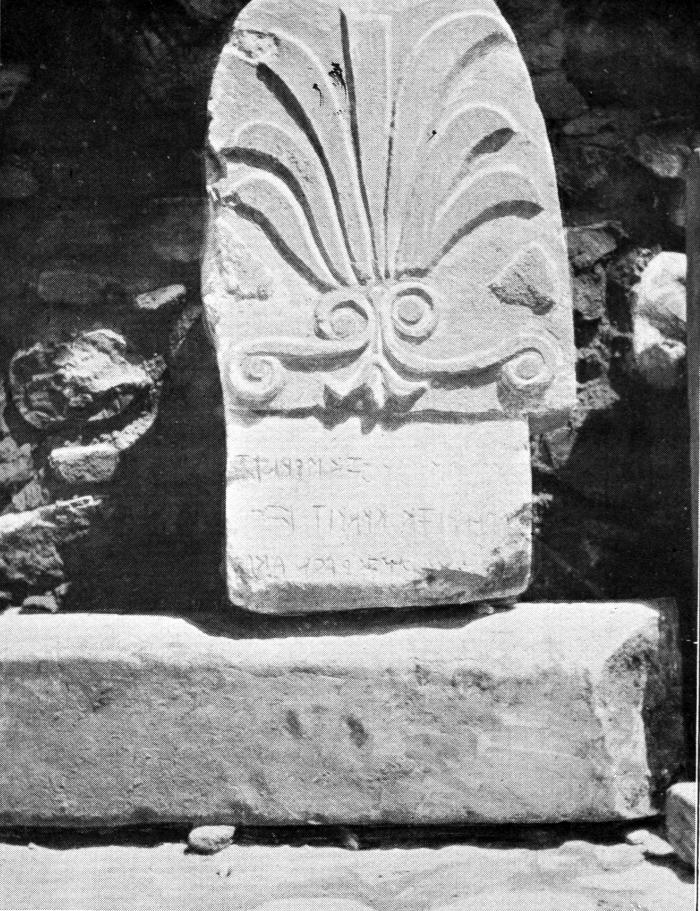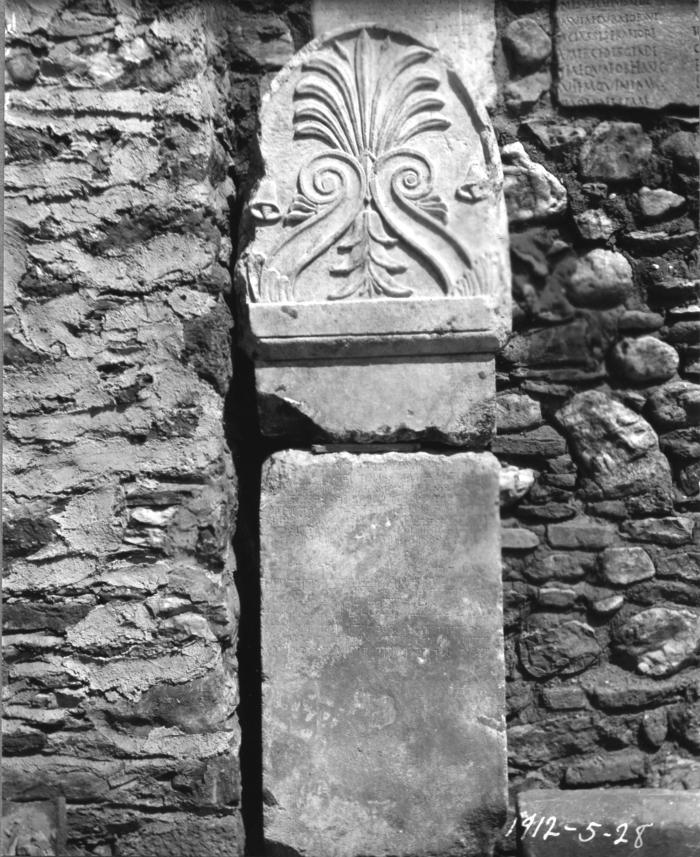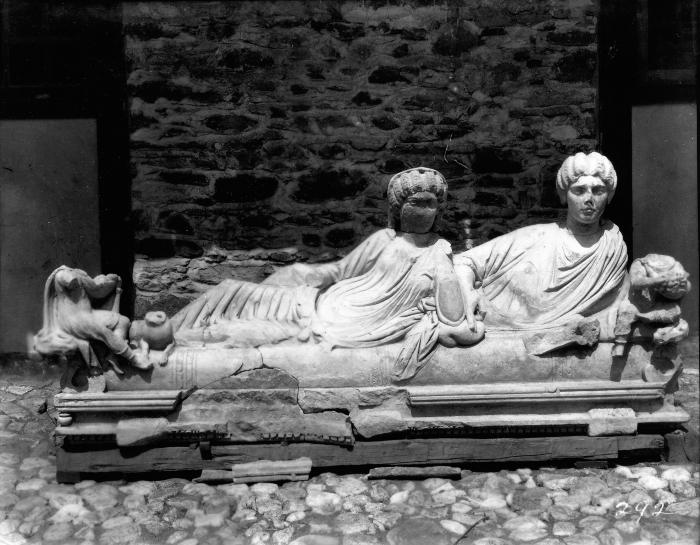-
 Part of Sepulchral Stele with Palmette
Part of Sepulchral Stele with PalmetteR2 Cat. 240
Sculpture
Marble, Stone
Ca. 420-400 BC (Late Lydian (Persian))
The stele has an oval finial, seven-petalled palmette on antithetic horizontal spirals, and downward-pointed small lotus. The anthemion projects slightly to the spectator's r. "The lateral projection ... was probably next to the dromos, whereas the s...
-
 Anthemion with Lydian-Aramaic Bilingual Inscription, Stele of Manes, Son of Kumlis
Anthemion with Lydian-Aramaic Bilingual Inscription, Stele of Manes, Son of KumlisR2 Cat. 241
Sculpture
Marble, Stone
394 BC (Late Lydian (Persian))
Two vertical half-volutes grow out of small acanthus chalices to support a seven-leaf simple palmette. Two small flowers (or ears of corn?) flank the central petal. Three large downward-pointed chalices are in the center below the palmette. Below the...
-
 Stele of Alikres, Son of Karos
Stele of Alikres, Son of KarosR2 Cat. 242
Sculpture
Marble, Stone
Early 4th C. BC (Late Lydian (Persian))
Funerary stele with Lydian inscription and rounded palmette anthemion, stele of Alikres, son of Karos.
Grayish "local" marble. Much reddish incrustation on face. Piece of marble broken off at top. According to Buckler (Sardis VI, 2, 49) bottom is origi...
-
 Sarcophagus of Claudia Antonia Sabina
Sarcophagus of Claudia Antonia SabinaR2 Cat. 243
Sculpture, Sarcophagus
Marble, Stone
2nd or early 3rd C. AD (Roman)
For full description and discussion, see Sardis V, 3ff.; Mansel, Erwerbungsbericht, 176, fig. 6; Ferrari, Commercio Sarcofagi, 39; Lawrence, Additional Sarcophagi, 116ff.; Wiegartz, Säulensarkophage, 158 (Istanbul G) and further bibliography therein....
-
 Sarcophagus Fragment
Sarcophagus FragmentR2 Cat. 244
Sculpture, Sarcophagus
Marble, Stone
Ca. 170-180 AD (Roman)
The corner fragment comprises "the cornice of the left intercolumniation of a lateral face, and the left extremity of the adjacent raking cornice" (Sardis V, 39). The interior border is raised to hold the lid. The acroteria consist of a headless anim...
-
 Stele of Menophila
Stele of MenophilaR2 Cat. 245
Sculpture
Marble, Stone
2nd or 1st C. BC (Hellenistic)
The pediment has three acroteria: the central one has two snakes pointing downwards; the other two each have one snake pointing upwards. The recessed niche has tapering sides parallel to the stele sides. The relief shows a woman standing in a Pudicit...
-
 Statue of Moschine, Priestess of Artemis
Statue of Moschine, Priestess of ArtemisR2 Cat. 246
Sculpture
Marble, Stone
50-25 BC (Hellenistic)
The priestess stands twisted slightly to her l., her r. foot drawn back and resting on the toes. She wears a chiton, himation, and platformed sandals, and stands on a square inscribed base.
The himation is drawn from her r. to her l. side across her b...
-
 Winged Eros
Winged ErosR2 Cat. 247
Sculpture
Marble, Stone
Late 3rd C. BC (Hellenistic)
The nude, winged Eros, just older than a baby, stands with the weight on his r. leg, his head turned slightly to proper l. His r. arm is bent at the elbow and across the body. A small fragment of an arrow is held in his r. hand. The l. hand probably ...
-
 Triple Head of Hekate
Triple Head of HekateR2 Cat. 248
Sculpture
Marble, Stone
Roman? (Roman?)
The central head of the Hekateion has circular locks and a floral crown. The two lateral heads have ribbons in their hair which is parted in the center and falls in long locks on their shoulders. They wear turreted crowns. There are incised lines on ...
-
 Double-Sided Herm with Kouros Figure on One Side and Herm on the Other
Double-Sided Herm with Kouros Figure on One Side and Herm on the OtherR2 Cat. 249
Sculpture
Marble, Stone
1st or 2nd C. AD (Roman)
The kouros, treated as a frontal relief, stands with both feet together and both arms down the sides. A strand of hair remains on his r. shoulder. The neck, chest, and abdomen are outlined in a sharp, linear fashion. The pubic hair is somewhat styliz...
-
 Head of Augustus
Head of AugustusR2 Cat. 250
Sculpture
Marble, Stone
1st half of 1st C. AD (Roman)
The idealized head of Augustus is turned slightly to his I. The sharp lines for eyebrows are prominent; the large eyes have no markings for pupil or iris. The nose is sharp and pointed, the mouth small. The face is attractive, but remarkably lacking ...
-
 Head of the Elder Faustina
Head of the Elder FaustinaR2 Cat. 251
Sculpture
Marble, Stone
Ca. 140 AD (Roman)
The following description is after İnan-Rosenbaum: The back of the head is hollow and has a large dowel hole in the center flanked by two oblong dowel holes. Two other dowel holes at ear lobe level are broken away. There are drill channels in the hai...